The Cleaners
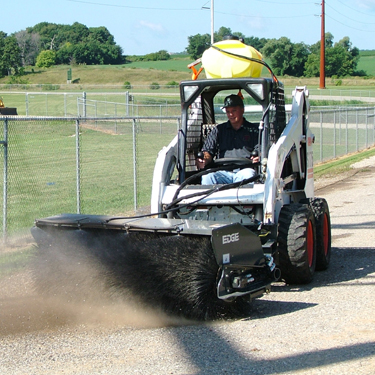 Construction is a dirty business. Sometimes to build and beautify you’ve got to break a few things, dig a few holes and bury the evidence that you were ever there. After the machines roll off the jobsite and the crews close their work orders, you will need to bring in the cleaners to finish the job.
Construction is a dirty business. Sometimes to build and beautify you’ve got to break a few things, dig a few holes and bury the evidence that you were ever there. After the machines roll off the jobsite and the crews close their work orders, you will need to bring in the cleaners to finish the job.
Like the “Law & Order” team you never get to see, the Special Broom Attachment Unit always shows up after the hotshot contractors conclude their work for the dirty job of cleaning and restoration. With the help of a broom attachment for a skid steer or compact track loader, these equipment custodians can sweep away the footprints of construction (and sometimes double in your seasonal Snow Removal Unit).
Before citizens can breathe a bit easier knowing the world is protected from dirt and debris, operators and crews must brush up on their knowledge of skid steer broom and sweeper attachments. In the attachment market, there are two separate but equally impressive brooms — rotary brooms that clean up the debris and the pickup ones that sweep and collect them.
Cleaning Up the Scene
Once a construction job is finished, dirty and random debris is usually left behind on the jobsite. Before fleeing the scene, crews must sweep away the pesky materials that may wreak havoc on the surrounding public. Your hard-working crew members can add a rotary broom to their tough taskforce to assist in their fight against grime.
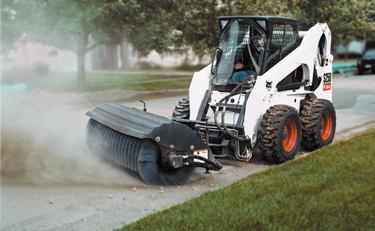
“With rotary brooms, just about any kind of loose material including dirt, gravel and general debris can be swept aside,” says Sweepster product manager Jim Koch.
However, he warns that large sticks, ropes or wires should be removed from the site prior to sweeping because they can become caught in the revolving parts of the broom.
Although a rotary broom creates more airborne debris and dust than push brooms and sweepers, it moves heavier debris easier. This particular kind of broom is best suited for areas where the materials can simply be swept away and not immediately collected, like streets, sidewalks, loading docks and warehouses. They are also ideal in intersections where paved roads and gravel roads meet and have an excess of gravel, or on turf when debris or dirt need to be swept off.
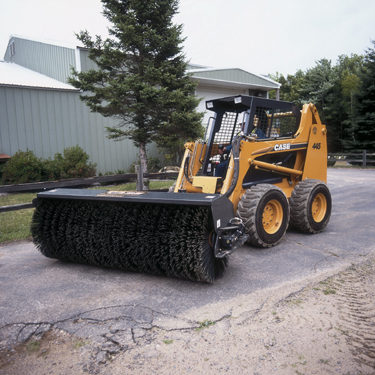
it comes to removing snow. Rotary brooms can even work on grass surfaces because the brush can be adjusted to work in more delicate work environments without losing efficiency.
To aid operators in their cleaning assignment, a spray kit attachment can be added to their rotary brooms. The kit helps to reduce visible dust when sweeping by releasing a fine mist of water ahead of the machine. By doing so, the mist knocks any rising dust to the ground and allows it to be swept to the side. This also prevents dust or flying debris from bothering the operator and the surrounding public.
Spray kits can be attached to any kind of broom. Koch explains that most types of brooms have the ability to add a kit. However, where the kit is mounted is dependent on the individual sweeper model. Although the nozzles are placed on the front of the brush, the water tank can be mounted in a variety of different places depending on its size and weight. Therefore, the location of the tank depends on the structure of the sweeper itself and the lift capacity of the loader. Some operators opt to mount the tank on top of the loader, in order to keep the weight of the water from interfering with the broom and to increase visibility for the driver. The cost of spray kits can range anywhere from $850 to $1,100.
Collecting the Evidence
A main part of any crime-solving, prime time drama is the brave detectives collecting evidence to piece together the crime that occurred hours before. In the everyday real-life dramas of the construction site, crews must clear away the dust and debris of their work, leaving no clue they were ever there. With the assistance of pickup brooms, crews can sweep and collect the assorted materials — wiping the site clean.
Pickup brooms (a.k.a. sweepers) collect debris into a bucket or hopper, enabling it to be transported and disposed of after restoration. The brooms can collect a wide range of materials, allowing crews to leave the area free of work-related debris.
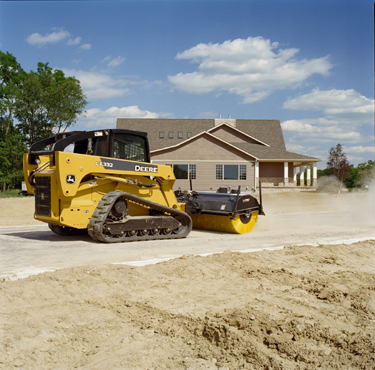
However, the brooms could experience trouble sweeping up certain items due to their weight. “Sweepers may have a difficult time collecting plastic pop bottles or cans because they are so light they tend to get pushed around,” adds Justin Odegaard, Bobcat attachment product representative.
The pickup broom consists of a collection bucket that is located behind the broom and a shroud that goes over the brush. Sweepers can be used in both forward and reverse. “When moving forward, it is easiest to have the brush spinning so that debris moves up and over the brush and back into the bucket,” says Sarah Falkavage, sales and marketing specialist for CE Attachments. “When moving in reverse, it’s easiest to have the brush spinning so that debris is flicked up and into the bucket — similar to a kitchen broom and dust pan.”
Pickup sweepers are ideal in conditions where the material that is swept needs to be collected and removed from the area. Parking lots, urban areas and streets are prime spots for pickup brooms, since they need to be kept clean during construction. Once the retention bucket is full, operators can either dump the debris at ground height or lift the sweeper with the skid steer loader arms and dump the material into a truck bed. Retention buckets have a load capacity between 10 and 25 cu ft. Sweeper-style brooms require more consideration of the lift capacity of a skid steer because of the additional weight involved in collecting material and dumping it. Operators should also consider how big and how heavy the material is.

Gutter brooms can also be called in for backup to assist the sweeper with its task. For an additional cost, gutter brooms can be purchased to help pull swept material away from the curb and into the path of the main brush so it can be collected, says Koch.
“Gutter brooms are attached to either side of a pickup broom to move material from the edge of a gutter, fence line or any other obstacle, to the front of the broom so it can be picked up into the hopper,” says Falkavage. Gutter broom attachments can cost anywhere from $1,000 to $2,200.
Broom Interrogation
To get a little more in-depth with these attachments and their debris-fighting characteristics, basic questions should be addressed such as operational guidelines and price. By grilling industry professionals on the statistics and features of the individual brooms, crews can determine which broom best fits the profile as their durable sweeping machine.
Pickup and rotary brooms are made up of sets of bristles that enable the operator to clean a variety of areas from a dirty jobsite to a cluttered street. There are two types of bristles available for the brooms — polypropylene and crimped wire. Koch says that a combination of the two materials has been the most popular among his consumers.
“The combination of the two provides the aggressive surface contact of wire and the flicking and cleaning action of polypropylene,” explains Koch.
However, polypropylene is preferred when cleaning deep material. “All polypropylene brushes are used when dealing with decorative surfaces, because the wire may damage the surface that’s being swept,” says Koch. Although brooms are primarily used on paved surfaces, polypropylene brushes can also be used on ceramic tile. Wire brushes are ideal for cleaning tougher surfaces. The wire contacts the area with an aggressive scratching action, which can be effective for sweeping the debris but damaging to the surface.
Pickup sweepers are available in widths of 3 ft up to 7 ft. Rotary brooms can range from 4 to 9 ft. Owners and operators need to discuss the appropriate size for their loader with the machine’s dealer.
Particular operational precautions must be taken to effectively use pickup and rotary brooms. Brush adjustment should be a top priority for broom operators. The proper adjustment will clean the area efficiently and hinder wear on the brush, allowing it a longer lifespan.
“The brush adjustment should be checked every day before sweeping to be sure the brush is contacting the surface at the right pressure,” explains Koch. “Pressure is measured by the brush pattern, which is the clean area left when the brush is rotated in one spot. A good pressure pattern will be 2 to 4 in. Excessive down pressure will result in poor sweeping performance and excessive brush wear.”
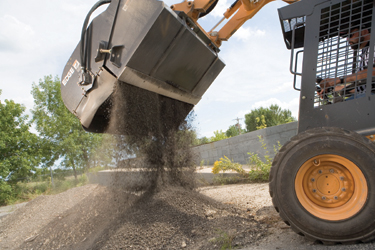
“One of the most common ways operators misuse the sweeper attachment is by applying too much down pressure on the bristles,” says Odegaard, noting that Bobcat rotary brooms have a spring assisted float mechanism to improve bristle life. “If you reduce the amount of down pressure on the bristles, they’ll sweep more effectively.”
The ground operation speed that the loaders must maintain during sweeping varies between the types of brooms. Loaders with pickup brooms should function between 2 to 3 mph. Since these brooms collect the material, they require a slower speed and more time to grab the debris. Rotary brooms can travel up to 5 mph, depending on the amount of waste that is being swept.
Price is important when adding a new piece of equipment to your force. Pickup brooms can cost anywhere from $3,000 to $5,000 for standard models. When equipped with all the possible options, such as gutter brooms and vacuum dust suppression systems, these brooms can cost up to $11,000, according to Koch. Rotary brooms usually start around $2,500 for a 48-in. model and can cost nearly $6,000 for an 84 in. However, prices may shift depending on the options the owner decides to add.
When the debris starts piling up and the jobsite seems to get uncontrollable, construction crews can call on the Special Broom Attachment Unit to sweep away (and even collect) the trash and waste that haunts the site — making the work area cleaner and safer for the public.
Doing Up-Time
With a little maintenance, brooms are in it for the long haul
Simple maintenance should be done to the brooms to ensure their long-lasting performance. Brush adjustments should be checked on a daily basis.
“Owners and operators should refer to their owner’s manual and work with the dealer to define the proper adjustments for their individual machines,” says Koch.
The adjustments will prevent excessive wear over time. An overall inspection of the machine and its hydraulic components is necessary, as well. The machine should be checked for signs of wear, and the components should be lubricated in accordance to the machine’s operator’s manual.
Over the course of a broom’s life, its bristles may need to be replaced. There are three key indicators to let you know that it might be time for a new set of sweeping teeth. First, the sweeper’s performance should be monitored. If it is not achieving results at the level it’s expected to, it may be time to replace the bristles. Second, the bristles may need to be replaced if the brush adjustment has reached its maximum peak. Finally, Koch advises that the bristles themselves should be checked. If the bristles have reached the length of 2 or 3 in., it’s time for them to be replaced. Koch says the cost to replace the bristles depends on the width and the material of the brush, with prices ranging from $275 to $650.
When the broom is not in use, it should be adjusted so it is off of the ground. The bristles can be permanently damaged if the broom is stored with pressure on it. The hydraulic connectors should also be kept clean while the pickup broom is in storage. Storage stands are also suggested to use when a rotary broom is not in operation. Odegaard says the stand helps to eliminate bristle distortion, preserving the life of the brush.

Comments are closed here.